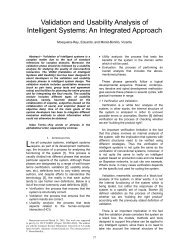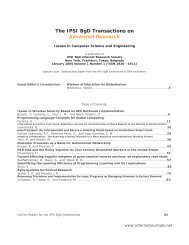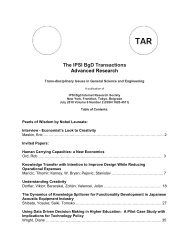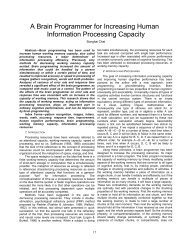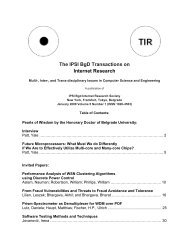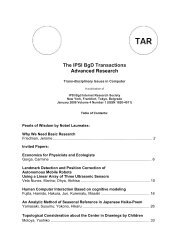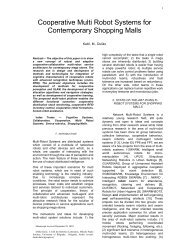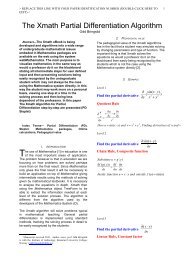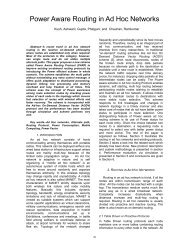The IPSI BgD Transactions on Internet Research - Welcome
The IPSI BgD Transactions on Internet Research - Welcome
The IPSI BgD Transactions on Internet Research - Welcome
Create successful ePaper yourself
Turn your PDF publications into a flip-book with our unique Google optimized e-Paper software.
3. THE BASIC REASON SEEMS TO BE THE<br />
OLD NEWTONIAN SCIENTIFIC PARADIGM<br />
A 300-year old paradigm requires us to focus<br />
up<strong>on</strong> matters that can be documented, and to<br />
avoid c<strong>on</strong>gesti<strong>on</strong> and other subjective and fuzzy<br />
matters. It is still a firm basis in the higher educati<strong>on</strong><br />
of engineers and ec<strong>on</strong>omists. This is of<br />
course valuable in many cases; however, it can<br />
be disadvantageous in some circumstances.<br />
Working with plans for large projects and<br />
other ventures, the planners and estimators have<br />
to work with incomplete project material, specificati<strong>on</strong>s,<br />
etc. when preparing the basis for a<br />
budget. <str<strong>on</strong>g>The</str<strong>on</strong>g> cost of the documented material is<br />
carefully detailed and skilfully calculated <strong>on</strong> the<br />
basis of historical data and other experience. In<br />
additi<strong>on</strong>, they tend to assume that implementati<strong>on</strong><br />
will be relatively c<strong>on</strong>trolled, and unhampered<br />
by major problems. Finally, they apply a traditi<strong>on</strong>al<br />
dispensati<strong>on</strong> whereby a somewhat arbitrary<br />
10% is added for c<strong>on</strong>tingencies without any<br />
documentati<strong>on</strong>.<br />
4. THIS INEVITABLY CAUSES OVERRUNS<br />
A still larger part of the project is not documented<br />
even at the point when the crucial decisi<strong>on</strong>s<br />
have to be taken. Add to this that a c<strong>on</strong>venti<strong>on</strong>al<br />
budget estimate takes no relevant account<br />
of factors such as future added facilities,<br />
complicati<strong>on</strong>s, requirements, unforeseen influence<br />
exerted by authorities, the owner, the users,<br />
local NGOs, nature’s caprices, human failures,<br />
etc., etc.: all typically – but not always –<br />
representing much larger amounts than the 10%<br />
c<strong>on</strong>tingency figure. No w<strong>on</strong>der we often experience<br />
large overruns.<br />
Another c<strong>on</strong>siderati<strong>on</strong> is that the many parties<br />
who have a stake in getting the project approved/authorised<br />
naturally wholeheartedly accept<br />
the aforementi<strong>on</strong>ed c<strong>on</strong>venti<strong>on</strong>al and wholly<br />
”legal” budgets.<br />
5. RISK ANALYSIS PROCEDURES<br />
AS A SOLUTION<br />
Various risk analysis procedures has been<br />
developed attempting to remedy unc<strong>on</strong>trolled<br />
overruns and delays. <str<strong>on</strong>g>The</str<strong>on</strong>g>y all include identificati<strong>on</strong><br />
of sources of uncertainty, an evaluati<strong>on</strong><br />
phase, and typically a M<strong>on</strong>te Carlo calculati<strong>on</strong> of<br />
the result, c<strong>on</strong>sisting of a mean value and a<br />
standard deviati<strong>on</strong>, or the so-called S-curve, linking<br />
probability to keep to budget versus budget<br />
size. A primary method is the Range Method,<br />
developed by Michael W. Curran already around<br />
1970 [4].<br />
<str<strong>on</strong>g>The</str<strong>on</strong>g> existing methods generally suffer from<br />
sufficiently covering identificati<strong>on</strong> of sources of<br />
uncertainty, from biased quantitative evaluati<strong>on</strong>,<br />
and from lack of efficient handling the statistical<br />
correlati<strong>on</strong>s am<strong>on</strong>g various uncertain factors. A<br />
huge amount of uncertain factors do also hinder<br />
a thorough treatment 2 .<br />
<str<strong>on</strong>g>The</str<strong>on</strong>g>se problems, since the early 1970´s has<br />
been in focus with a successful result, as further<br />
developed below.<br />
6. A NEW GUARANTEE AGAINST<br />
UNPLANNED OVERRUNS<br />
However, a somewhat untraditi<strong>on</strong>al procedure<br />
has been developed which brings you very close<br />
to a guarantee against overruns, except in the<br />
case of major catastrophes, obviously. It is<br />
known as the Successive Principle*. It was developed<br />
during the 1970s and later by the author<br />
and colleagues.<br />
One example is the complex high-tech, multipurpose<br />
10,000-seat arena, Oslo Spectrum in<br />
Norway. <str<strong>on</strong>g>The</str<strong>on</strong>g> original budget was $45 milli<strong>on</strong>.<br />
<str<strong>on</strong>g>The</str<strong>on</strong>g> use of the Successive Principle three years<br />
later, before the project was due to start, identified<br />
$125 milli<strong>on</strong> as a realistic cost. <str<strong>on</strong>g>The</str<strong>on</strong>g> project<br />
was then rati<strong>on</strong>alised, after which an analysis<br />
process generated $80 milli<strong>on</strong> as a mean value*<br />
+/- approx. $10 milli<strong>on</strong> as the standard deviati<strong>on</strong>*.<br />
<str<strong>on</strong>g>The</str<strong>on</strong>g> project organisati<strong>on</strong> was allotted the<br />
$80 milli<strong>on</strong> as a budget, while the official building<br />
committee was given the $10 milli<strong>on</strong> as a reserve.<br />
However this reserve was never used.<br />
<str<strong>on</strong>g>The</str<strong>on</strong>g> official<br />
project account<br />
after the successful<br />
erecti<strong>on</strong><br />
deviated by less<br />
than 1% from<br />
the calculated<br />
mean value.<br />
Oslo Spectrum in Norway<br />
Another example is the Lillehammer Olympic<br />
Games. <str<strong>on</strong>g>The</str<strong>on</strong>g> initial budget rose from $230 milli<strong>on</strong><br />
to $385 milli<strong>on</strong> over the summer, more than four<br />
years before the games. A risk analysis showed<br />
an expected final total cost of $1230 milli<strong>on</strong>. This<br />
was of course politically unacceptable. <str<strong>on</strong>g>The</str<strong>on</strong>g> investment<br />
plans were then reorganised –<br />
<str<strong>on</strong>g>The</str<strong>on</strong>g> Lillehammer Olympic Games.<br />
2 <str<strong>on</strong>g>The</str<strong>on</strong>g> range method, however have solved this particular<br />
problem.<br />
34



